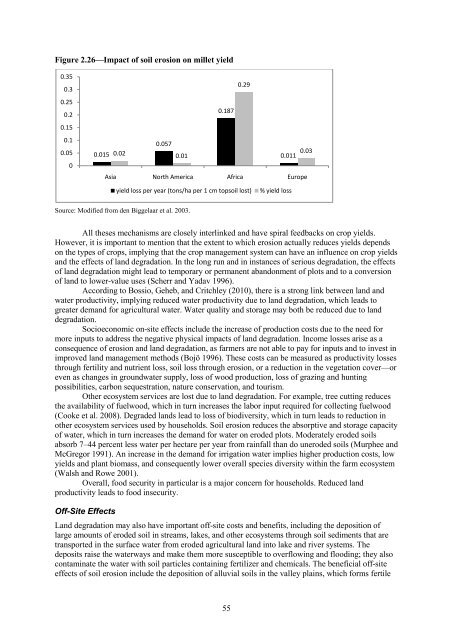The Economics of Desertification, Land Degradation, and Drought
The Economics of Desertification, Land Degradation, and Drought
The Economics of Desertification, Land Degradation, and Drought
You also want an ePaper? Increase the reach of your titles
YUMPU automatically turns print PDFs into web optimized ePapers that Google loves.
Figure 2.26—Impact <strong>of</strong> soil erosion on millet yield<br />
0.35<br />
0.3<br />
0.25<br />
0.2<br />
0.15<br />
0.1<br />
0.05<br />
0<br />
0.015<br />
0.057<br />
0.02 0.01<br />
Source: Modified from den Biggelaar et al. 2003.<br />
0.187<br />
All theses mechanisms are closely interlinked <strong>and</strong> have spiral feedbacks on crop yields.<br />
However, it is important to mention that the extent to which erosion actually reduces yields depends<br />
on the types <strong>of</strong> crops, implying that the crop management system can have an influence on crop yields<br />
<strong>and</strong> the effects <strong>of</strong> l<strong>and</strong> degradation. In the long run <strong>and</strong> in instances <strong>of</strong> serious degradation, the effects<br />
<strong>of</strong> l<strong>and</strong> degradation might lead to temporary or permanent ab<strong>and</strong>onment <strong>of</strong> plots <strong>and</strong> to a conversion<br />
<strong>of</strong> l<strong>and</strong> to lower-value uses (Scherr <strong>and</strong> Yadav 1996).<br />
According to Bossio, Geheb, <strong>and</strong> Critchley (2010), there is a strong link between l<strong>and</strong> <strong>and</strong><br />
water productivity, implying reduced water productivity due to l<strong>and</strong> degradation, which leads to<br />
greater dem<strong>and</strong> for agricultural water. Water quality <strong>and</strong> storage may both be reduced due to l<strong>and</strong><br />
degradation.<br />
Socioeconomic on-site effects include the increase <strong>of</strong> production costs due to the need for<br />
more inputs to address the negative physical impacts <strong>of</strong> l<strong>and</strong> degradation. Income losses arise as a<br />
consequence <strong>of</strong> erosion <strong>and</strong> l<strong>and</strong> degradation, as farmers are not able to pay for inputs <strong>and</strong> to invest in<br />
improved l<strong>and</strong> management methods (Bojö 1996). <strong>The</strong>se costs can be measured as productivity losses<br />
through fertility <strong>and</strong> nutrient loss, soil loss through erosion, or a reduction in the vegetation cover—or<br />
even as changes in groundwater supply, loss <strong>of</strong> wood production, loss <strong>of</strong> grazing <strong>and</strong> hunting<br />
possibilities, carbon sequestration, nature conservation, <strong>and</strong> tourism.<br />
Other ecosystem services are lost due to l<strong>and</strong> degradation. For example, tree cutting reduces<br />
the availability <strong>of</strong> fuelwood, which in turn increases the labor input required for collecting fuelwood<br />
(Cooke et al. 2008). Degraded l<strong>and</strong>s lead to loss <strong>of</strong> biodiversity, which in turn leads to reduction in<br />
other ecosystem services used by households. Soil erosion reduces the absorptive <strong>and</strong> storage capacity<br />
<strong>of</strong> water, which in turn increases the dem<strong>and</strong> for water on eroded plots. Moderately eroded soils<br />
absorb 7–44 percent less water per hectare per year from rainfall than do uneroded soils (Murphee <strong>and</strong><br />
McGregor 1991). An increase in the dem<strong>and</strong> for irrigation water implies higher production costs, low<br />
yields <strong>and</strong> plant biomass, <strong>and</strong> consequently lower overall species diversity within the farm ecosystem<br />
(Walsh <strong>and</strong> Rowe 2001).<br />
Overall, food security in particular is a major concern for households. Reduced l<strong>and</strong><br />
productivity leads to food insecurity.<br />
Off-Site Effects<br />
<strong>L<strong>and</strong></strong> degradation may also have important <strong>of</strong>f-site costs <strong>and</strong> benefits, including the deposition <strong>of</strong><br />
large amounts <strong>of</strong> eroded soil in streams, lakes, <strong>and</strong> other ecosystems through soil sediments that are<br />
transported in the surface water from eroded agricultural l<strong>and</strong> into lake <strong>and</strong> river systems. <strong>The</strong><br />
deposits raise the waterways <strong>and</strong> make them more susceptible to overflowing <strong>and</strong> flooding; they also<br />
contaminate the water with soil particles containing fertilizer <strong>and</strong> chemicals. <strong>The</strong> beneficial <strong>of</strong>f-site<br />
effects <strong>of</strong> soil erosion include the deposition <strong>of</strong> alluvial soils in the valley plains, which forms fertile<br />
55<br />
0.29<br />
0.011<br />
Asia North America Africa Europe<br />
yield loss per year (tons/ha per 1 cm topsoil lost) % yield loss<br />
0.03<br />
.

















